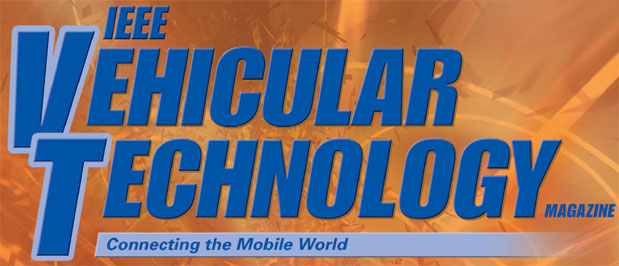Open Call for Papers on Mobile Radio
The Mobile Radio area within VTM is soliciting submissions in the seven major areas described below. Prospective authors are welcome to submit original tutorial, technical and research papers not published and not currently under consideration by any other publication or conference. Please follow the manuscript guidelines, which contain details on format and procedure:
Transmission Technology
Physical-layer (PHY) communication systems, Modulation and detection; Coding and decoding; Equalization; Synchronization; Channel estimation and prediction; MIMO and massive MIMO techniques; Millimeter-wave communications; Multiuser detection and interference cancellation; Multicarrier transmission; Full-duplex transmission; Transceiver design; Multiple access technologies: orthogonal and non-orthogonal signaling; Air-link design aspects for emerging technologies; Modelling and simulation of wireless transmission systems; Machine learning for wireless communications; Internet of things (IoT); Optical wireless communications; Software defined radio (SDR) and cognitive radio (CR); Terahertz (THz) communications; Underwater communications; PHY security; AI-driven transmission technologies.
Mobile Networks
Wide, local, and personal area networking; Proximity networking; Wearable computers and body area networks; All-IP mobile networks; All-IP RAN and CN architectures; Edge-based and cloud-based support of mobile services; Ad-hoc networks; Sensor networks; Ambient and intelligent wireless networks; Heterogeneous networking; Fixed/mobile networks integration and convergence; Seamless mobility management; Mobile agents; Affordable wireless infrastructure; Novel network & switching architecture; Information-centric networking (ICN); Network planning; End-to-end QoS provision and architectures; Routing, broadcasting, and multicasting; Software defined network and reconfigurability; Mobile/wireless networks modeling and simulation; Network security, authentication; Network resource allocation, AI-driven networking.
Antennas and Propagation
Energy-efficient antenna systems; Terahertz and optical antennas; Large-scale antenna systems; Massive MIMO and distributed antenna systems; Centimeter- and millimeter-wave antennas; Reconfigurable antennas; Miniature antennas for mobile handsets; Wearable antennas for IoT devices; Antennas for future-generation mobile radio systems; Over-the-air testing of mobile terminal antennas; EMC issues for wireless and mobile networks; Advanced Beamforming techniques; Hardware-aware beamforming; Reconfigurable Intelligent Surfaces (RIS); Measuring, modeling, analysis, and simulation of mobile radio channels; Massive MIMO channels; Centimeter- and millimeter-wave channels; Ultra-wideband channels; Indoor, outdoor, and indoor-to-outdoor channels; Channels for inter- and intra-vehicle communications; Car-2-X channels; Highly time-varying wireless channels for railroad communications; Air-to-ground channels for unmanned aerial vehicle (UAV) communications; Aeronautical and satellite channels; Optical wireless channels; Underwater acoustic channels; Software simulators and hardware emulators for mobile radio channels; Measurement and channel sounding techniques; Propagation prediction; Automatic frequency planning tools.
Mobile Access
Radio access in current- and future-generation mobile networks; Broadband wireless access; Radio access techniques for ultra-reliable and low latency communications (URLLC); Radio access techniques for IoT and MTC; Radio access techniques for mission critical services; Radio resource management; Self organizing networks; Interference management and interference coordination; QoS and resource allocation; Multi-connectivity and dual connectivity; Radio access techniques for heterogeneous wireless networks; Beam management; Bandwidth adaptation; Bandwidth on demand; Dynamic bandwidth management; Mobility control; Handoff/handover; Scheduling; admission control; Flow control; Load control; Link adaptation; Hybrid ARQ schemes; MAC protocols; Dynamic channel allocation; Channel assignment and reservation schemes; Power control; Energy efficient protocols; Network sharing; Radio access network (RAN) slicing; Multi-tenancy in radio access networks; Virtualization in radio access networks; Cloud RAN; Software defined networks applied to the radio access; Analytics applied to the radio access; Cognitive radio; AI-driven air interface; Operation in unlicensed frequency bands; Cross-layer design and optimization; Techniques for flexible spectrum usage; Spectrum sharing; Spectrum management, usage, and regulation; AI-based interference avoidance; Policy issues and frequency regulations.
Mobile Services, Applications, and Systems
Innovative services and applications; Integration of broadcast services into point-to-point mobile systems; Location-based services; Case studies and field experience; Applications enabling technologies and middleware; Service platforms; Mobile traffic modeling and characterization; Service portability; Wireless ecommerce; Policy-based management for wireless multimedia services; Wireless security; Privacy and authentication; Federated Learning; Federated database.
Green Communications and Networks
Communication technologies for energy efficient networks; Communication technologies for energy harvesting; Zero-energy devices; Tags and RFIDs; Low-power sensor networks; RIS-based sensing; Cross-layer optimization for green networks; Electromagnetic pollution mitigation; Energy-aware self-organized networks; Energy-aware system design; Energy consumption management; Energy-efficient heterogeneous networks; Field trials and deployment experiences; Green cooperative communications; Green cloud computing; Green IoT; Green mobile and wireless communications; Hybrid fiber-wireless networks for energy efficient delivery of wireless signals; Radio resource management for green wireless systems; Wireless power transfer.
Positioning, Navigation, and Mobile Satellite Systems
Cellular based positioning and hybrid approaches; Cooperative deep space communications; Digital broadcasting over satellite networks; Distributed and collaborative localization algorithms; Energy efficient positioning systems; Indoor positioning technologies; RIS-aided localization; Integrated positioning and communication; IP over satellite; MIMO positioning techniques; Mobile satellite communication systems; Integration of terrestrial and non-terrestrial networks; Satellite and terrestrial navigation and positioning techniques; Transmission technology for positioning; UWB and narrowband positioning systems and algorithms; Quantum GPS; Underwater GPS.

